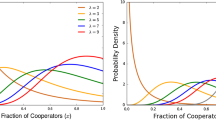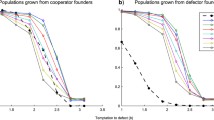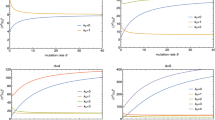Abstract
The effects of an inhomogeneous competing environment on the extent of cooperation are studied within the context of a site-diluted evolutionary snowdrift game on a square lattice, with the occupied sites representing the players, both numerically and analytically. The frequency of cooperation ℱ C generally shows a non-monotonic dependence on the fraction of occupied sites ρ, for different values of the payoff parameter r. Slightly diluting a lattice leads to a lower cooperation for small and high values of r. For a range of r, however, dilution leads to an enhanced cooperation. An analytic treatment is developed for ℱC I + ℱC II, with ℱC I emphasizing the importance of the small clusters of players especially for ℱC II from the other players is shown to be inadequate. A local configuration approximation (LCA) that treats the local competing configurations as the variables and amounts to include spatial correlation up to the neighborhood of a player’s neighbors is developed. Results of ℱ C (ρ) and the number of different local configurations from LCA are in good agreement with simulation results. A transparent physical picture of the dynamics stemming from LCA is also presented. The theoretical approach provides a framework that can be readily applied to competing agent-based models in structurally ordered and disordered populations.
Similar content being viewed by others
References
R. Axelrod, W.D. Hamilton, Science 211, 1390 (1981)
R.M. May, Nature 292, 291 (1981)
M.A. Nowak, R.M. May, Nature 359, 826 (1992)
K. Brauchli, T. Killingback, M. Doebeli, J. Theor. Biol. 200, 405 (1999)
G. Szabó, C. Hauert, Phys. Rev. Lett. 89, 118101 (2002)
F.C. Santos, J.M. Pacheco, Phys. Rev. Lett. 95, 098104 (2005)
M.A. Nowak, Science 314, 1560 (2006)
O. Gräser, C. Xu, P.M. Hui, New J. Phys. 13, 083015 (2011)
Z. Wang, A. Szolnoki, M. Perc, Sci. Rep. 2, 369 (2012)
R. Axelrod, The Evolution of Cooperation (Basic Books, New York, 1984)
M. Nakamaru, H. Matsuda, Y. Iwasa, J. Theor. Biol. 184, 65 (1997)
V.C.L. Hutson, G.T. Vickers, Phil. Trans. R. Soc. London B 348, 393 (1995)
P. Grim, BioSystems 37, 3 (1996)
M.A. Nowak, S. Bonhoeffer, R.M. May, Proc. Natl. Acad. Sci. USA, 91, 4877 (1994)
F.C. Santos, J.M. Pacheco, T. Lenaerts, Proc. Natl. Acad. Sci. USA, 103, 3490 (2006)
A. Cassar, Games Econ. Behav. 58, 209 (2007)
L.-X. Zhong, D.-F. Zheng, B. Zheng, C. Xu, P.M. Hui, EPL 76, 724 (2006)
V. Sasidevan, S. Sinha, Sci. Rep. 5, 13071 (2015)
A. Bovier, Statistical Mechanics of Disordered Systems (Cambridge University Press, Cambridge, 2006)
D. Stauffer, A. Aharony, Introduction to Percolation Theory, 2nd edn. (Taylor & Francis, 1992)
J. Marro, A. Labarta, J. Tejada, Phys. Rev. B 34, 347 (1986)
M.H. Vainstein, J.J. Arenzon, Phys. Rev. E 64, 051905 (2001)
J.-Y. Guan, Z.-X. Wu, Y.-H. Wang, Chin. Phys. 16, 3566 (2007)
M.A. Nowak, S. Bonhoeffer, R.M. May, Int. J. Bifurc. Chaos 4, 33 (1994)
E.A. Sicardi, H. Fort, M.H. Vainstein, J.J. Arenzon, J. Theor. Biol. 256, 240 (2009)
C. Hauert, M. Doebeli, Nature 428, 643 (2004)
B. Skyrms, The Stag Hunt and the Evolution of Social Structure (Cambridge University Press, Cambridge, 2004)
W. Zhang, C. Xu, P.M. Hui, Eur. Phys. J. B 86, 196 (2013)
M.G. Zimmermann, V.M. Eguíluz, Phys. Rev. E 72, 056118 (2005)
O. Gräser, C. Xu, P.M. Hui, EPL 87, 38003 (2009)
F. Vazquez, V.M. Eguíluz, M. San Miguel, Phys. Rev. Lett. 100, 108702 (2008)
G. Demirel, F. Vazquez, G.A. Böhme, T. Gross, Physica D 267, 68 (2014)
C.-P. Zhu, H. Kong, L. Li, Z.-M. Gu, S.-J. Xiong, Physica A 375, 1378 (2011)
M. Ji, C. Xu, C.W. Choi, P.M. Hui, New J. Phys. 15, 113024 (2013)
T. Gross, C. D’Lima, B. Blasius, Phys. Rev. Lett. 96, 208701 (2006)
T. Gross, I. Kevrekidis, EPL 82, 38004 (2008)
L.B. Shaw, I.B. Schwartz, Phys. Rev. E 77, 066101 (2008)
O. Gräser, P.M. Hui, C. Xu, Physica A 390, 906 (2011)
C. Nardini, B. Kozma, A Barrat, Phys. Rev. Lett. 100, 158701 (2008)
V. Marceau, P.-A. Noël, L. Hébert-Dufresne, A. Allard, L.J. Dubé, Phys. Rev. E 82, 036116 (2010)
J.P. Gleeson, Phys. Rev. Lett. 107, 068701 (2011)
P. Holme, M.E.J. Newman, Phys. Rev. E 74, 056108 (2006)
R. Durrett, J.P. Gleeson, A.L. Lloyd, P.J. Mucha, F. Shi, D. Divakoff, J.E.S. Socolar, C. Varghese, Proc. Natl. Acad. Sci. USA 109, 3682 (2012)
F. Vazquez, V.M. Eguíluz, New J. Phys. 10, 063011 (2008)
P. Klimek, R. Lambiotte, S. Thurner, EPL 82, 28008 (2008)
P. Weiss, J. Phys. 6, 661 (1907)
P. Fulde, Electron Correlations in Molecules and Solids (Springer, 2002)
Y. Harada, Y. Iwasa, Res. Popul. Ecol. 36, 237 (1994)
S.P. Ellner, J. Theor. Biol. 210, 435 (2001)
F. Fu, M.A. Nowak, C. Hauert, J. Theor. Biol. 266, 358 (2010)
Y.-C. Ni, H.P. Yin, C. Xu, P.M. Hui, Eur. Phys. J. B 80, 233 (2011)
C. Xu, P.M. Hui, unpublished
N.W.H. Chan, C. Xu, S.K. Tey, Y.J. Yap, P.M. Hui, Physica A 392, 168 (2013)
Author information
Authors and Affiliations
Corresponding author
Rights and permissions
About this article
Cite this article
Xu, C., Zhang, W., Du, P. et al. Understanding cooperative behavior in structurally disordered populations. Eur. Phys. J. B 89, 152 (2016). https://doi.org/10.1140/epjb/e2016-60826-y
Received:
Revised:
Published:
DOI: https://doi.org/10.1140/epjb/e2016-60826-y




